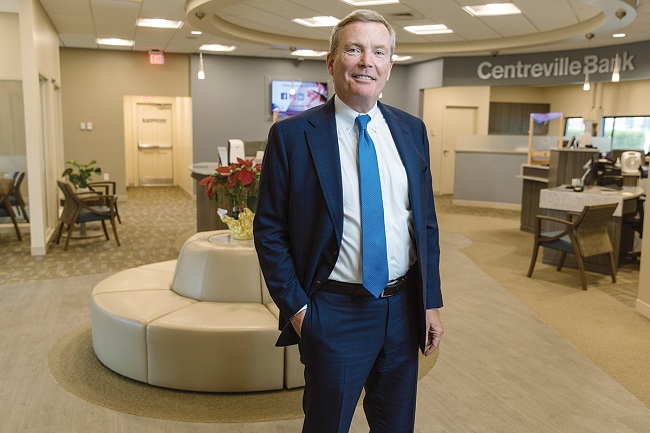
Harold M. Horvat has been leading West Warwick-based Centreville Bank as chairman, CEO and president since 2019. He oversaw the bank’s acquisition of Connecticut-based Putnam Bank for $115.5 million a few months later. The move gave Centreville entry into the eastern Connecticut market.
Most recently, Centreville announced the opening of a loan production office in Middletown, the bank’s first presence on the other side of Narragansett Bay. Horvat speaks about the bank’s future growth plans.
PBN: What are Centreville Bank’s expansion plans for 2023?
HORVAT: It’s an exciting time for Centreville Bank. We’re celebrating our 195th anniversary this year and we’re growing. A new full-service branch will open in April in Smithfield, where the old Benny’s store used to be, and then another branch will open in Newport on Thames Street around Memorial Day. This is in addition to our Middletown loan production office that opened in February and a third loan production office opening in Warren later this spring. This will bring us to 21 locations throughout Rhode Island and eastern Connecticut.
PBN: Are there longer-range plans to establish a bigger foothold in the East Bay, and maybe into Massachusetts?
HORVAT: Expanding to the East Bay area has been part of our strategic plan for some time, so we’re very pleased to increase our presence there. Between our Newport branch and Middletown and Warren loan production offices, we will offer a full suite of personal and commercial banking products, including residential and consumer lending, commercial lending, as well as cash management services. This also means Centreville has locations in every county in Rhode Island.
At this time, we have no plans to expand into Massachusetts, but as we continue to grow, this is an area we are considering.
PBN: It seems like many banks are expanding their physical presence in new markets right now. It feels almost counterintuitive in the age of online banking. How do explain that strategy from Centreville’s perspective?
HORVAT: At Centreville, our strategy is really a combination of offering the latest technologies and “good old-fashioned” brick-and-mortar service. On the technology side, we aim to invest in and offer the best tech and digital services we can. Tools like mobile banking apps, digital wallets, person-to-person transfers, contactless (tap) debit cards, interactive teller machines with video chat, and online appointment scheduling – all make it convenient for our customers to bank with us in the ways and at the times they prefer.
We also recognize that face-to-face service is still highly valued. It’s important for us to have a physical presence so our customers still have the option to come into the office or branch and meet personally with a bank representative. Particularly when it comes to significant financial transactions such as purchasing a home or obtaining a business loan, providing our customers with the opportunity to ask questions and discuss details in person is a critical aspect of our business.
PBN: On the depositor’s side of expanding into a new area, how does the bank persuade people to put their money in these new branches? Are you initially only serving people who already have a preexisting relationship with Centreville, such as having a mortgage or loan with the bank? Or are you offering incentives such as better rates on certificates of deposit? Aren’t people very “sticky” with their existing banks?
HORVAT: In terms of deposits, many times we are initially serving people who have an existing relationship with us. Our new locations may be more convenient for them, nearer to their work or home.
Certainly, with a highly competitive and saturated banking market, it can be a challenge to attract new customers. However, we have had a successful track record of raising awareness and welcoming new customers as we enter each market. We have done this by offering highly competitive rates on savings (CDs, money markets, IRAs) and loan (mortgages, home equity loans/lines of credit) products.
We also have a strong commercial lending team that enjoys deep relationships with customers across Rhode Island, Connecticut and Massachusetts. In fact, we were named the top SBA 504 Lender of the Year in 2022.
As for people being “sticky” with their existing bank, industry research shows – and we have also found in our experience – that many people bank with more than one institution. So, they may not be switching banks altogether; they might just be adding one. Overall, this creates more opportunities for both banks and consumers to find the best array of products and services for them.
PBN: Centreville is a mutual bank as opposed to a publicly traded one – the bank is technically owned by its depositors and customers – how does that affect the decision-making to expand? After all, aren’t mutual savings banks thought of as having a more conservative mindset?
HORVAT: Centreville Bank is indeed a mutual bank, so we don’t have stockholders, and yes, we are owned by our customers/depositors. This also means that we have 100% local decision-making, and we can take a more long-term view in our strategy and actions.
In terms of expansion, that’s precisely the steady growth approach we took in eastern Connecticut a few years ago with the acquisition of Putnam Bank and by adding loan offices as opposed to full-service branches in certain areas.
It is important that Centreville’s growth is in service to our customers. However, that does not mean we can become stagnant either. We must balance these two needs – for growth, whether it be physical, technological, etc., and for responsible, reliable banking.












